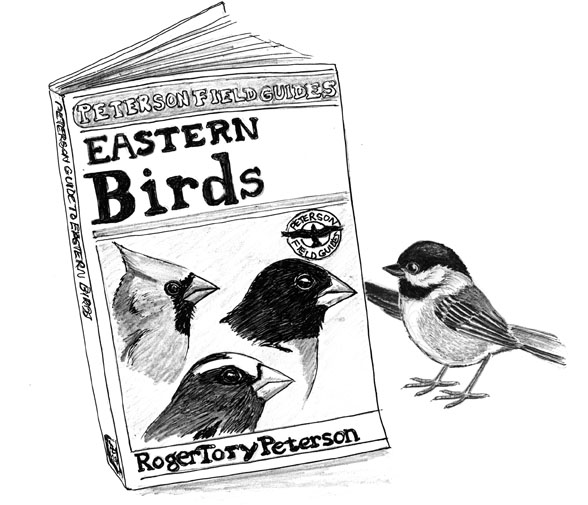
Dear Bird Folks,
My grandmother’s favorite bird book is the Peterson Guide. I recently noticed that she also has several other Peterson Guides, including books about mammals, fish, rocks and stars. How could one man be such an expert on so many topics?
– Sarah, Northborough, MA
Wait, Sarah,
Did you say your grandmother has a guide to “rock stars”? That’s awesome. Go, Grandma! You are never too old to rock and roll. I’ve seen a T-shirt with an inscription on the front that reads: “I may be old, but I got to see all the cool bands.” You should totally get that shirt for your grandmother. While you’re at it, get her a VW microbus, too. Then she could travel around to all of the festivals this summer and…hold on. I think I misread something. You wrote that your grandmother has a book on “rocks and stars,” not rock stars. Never mind.
There’s nothing flashy or glamorous about bird watchers. They are just normal people (well, semi-normal), dressed in outdated clothes, who walk very slowly and don’t talk much. Not really teen idols. But if one single birder has ever approached rock star status, it is the late Roger Tory Peterson. It can be argued that no other person in the field of ornithology, including John James Audubon and David Sibley (and perhaps even me), has had a bigger effect on birding than Roger Tory Peterson.
Before RTP (that’s what we people in the know call him) came along, bird identification books were extremely technical and difficult for the casual birder to use. These older books gave details that could be appreciated only if the observer actually had the bird in her or his hand. And what is the best way to get a bird in the hand? Shoot it, of course. (Ah, the good old days.) Unlike his predecessors, Peterson wasn’t into the whole gun thing. He thought there should be a way in which folks could identify a bird at a distance and not just when the bird was in the hand (and full of bullet holes).
Roger Tory Peterson grew up in Jamestown, NY and first became interested in birds when his seventh-grade teacher (yay, teachers!) turned him on to birding. Back in 1920 very few cell phones had built-in cameras; so if Roger wanted to remember the markings of a bird he saw in the field, he would simply sketch it. Those drawing skills helped him get his first summer job, which was painting designs on furniture. (Wouldn’t you love to have one of those pieces of furniture now?) Upon graduating from high school, Peterson decided there was more money in painting than there was in bird watching (ha, little did he know), so he moved to the Big Apple to study art. While in NYC, Peterson joined the Bronx County Bird Club where he met other young, soon-to-be-famous birders (who, at that moment in time, were all just unknown nerds). After finishing art school, Roger accepted a job teaching at the Rivers School in Brookline, MA. One of his first students was future U.S. Attorney General Elliot Richardson. (That last piece of information has nothing to do with your question, but it’s still a pretty cool fact.)
It was around this time that Peterson decided a better bird identification book was needed. With encouragement from his peers, he wrote and illustrated the first guide designed to help novice birders. It was a brilliant idea, except for one problem: None of the big New York book companies wanted to invest in an experimental book about silly birds. Who cares about birds, they thought. Much like the idiot record companies that refused to sign the early Beatles, publisher after publisher rejected the twenty-six-year-old Peterson…until Boston’s Houghton Mifflin Company took a chance. In 1934, at the height of the Great Depression, Peterson’s A Field Guide to the Birds was released. The nervous publisher held its breath and waited to see if it had made a bad business decision. It didn’t have to wait long. The first printing sold out in a week and the Peterson Field Guide series was born. Roger’s furniture painting days were over.
During the next six decades, more than seven million copies of Roger’s bird books have been sold. In addition, Houghton Mifflin cranked out more than fifty different Peterson Guides on subjects ranging from shells, to mushrooms, to trees…and yes, rocks and stars. Some of the guides were written and illustrated by Peterson himself, but most were produced by other folks, with Roger doing the editing to ensure the books followed his standards. So, to answer your question, Sarah, Roger didn’t write all of those Peterson Guides your grandmother has, but he was responsible for their format, a format that is still being copied by other publishers today.
By the late 1970s, when I became interested in birds, RTP was the elder statesman of birding. I would see him on TV with his fluffy white hair, giving some speech or accepting one of his many awards, including the Presidential Medal of Freedom. (Can you imagine a birder getting that?) With all of the business and accolades swirling around, it’s easy to forget how important Roger Tory Peterson was to not only birds, but to other wildlife and to nature in general. And although he never made the cover of the Rolling Stone, his writings and illustrations have undoubtedly inspired countless numbers of future scientists, researchers, environmental crusaders…and at least one very grateful bird store owner.